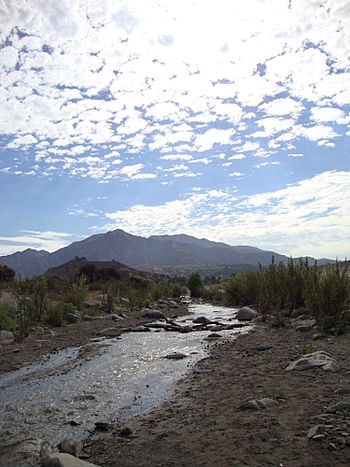Big Tujunga Creek facts for kids
Quick facts for kids Big Tujunga Creek |
|
|---|---|

The wash in lower Big Tujunga Canyon
|
|
| Other name(s) | Tujunga Creek, Tujunga River, Tujunga Wash |
| Country | United States |
| State | California |
| Cities | Sunland, Shadow Hills |
| Physical characteristics | |
| Main source | About 1.6 miles (2.6 km) south-southeast of Mount Mooney San Gabriel Mountains 5,768 ft (1,758 m) 34°17′52″N 118°00′11″W / 34.29778°N 118.00306°W |
| River mouth | Tujunga Wash Upstream of Hansen Dam 1,070 ft (330 m) 34°16′05″N 118°21′50″W / 34.26806°N 118.36389°W |
| Length | 22 mi (35 km) |
| Basin features | |
| Basin size | 130 sq mi (340 km2) |
| Tributaries |
|
Big Tujunga Creek is an important stream in Los Angeles County, California. It begins high up in the San Gabriel Mountains. The creek flows generally southwest for about 28.8 miles (46.3 km). It then joins Little Tujunga Creek to create the Tujunga Wash near Pacoima. If you include the Tujunga Wash, the stream's total length is more than 40 miles (64 km). The name of the stream comes from an old Tongva village name.
Contents
The Journey of Big Tujunga Creek
The creek starts near the Angeles Crest Highway. This is deep inside the Angeles National Forest. The upper part of the creek is very steep and rocky. It has many fast-moving sections, small waterfalls, and calm pools.
Where the Water Flows
The creek first flows west, then turns northwest. Along the way, it gets water from smaller streams. These include Alder Creek and Lynx Gulch from the right. Wildcat Gulch and Wickiup Creek join from the left. As the creek carves its way deeper into the canyon, a major stream called Mill Creek joins it. Fall Creek also adds water just before the creek flows into Big Tujunga Reservoir. This reservoir was created by the Big Tujunga Dam. While in the reservoir, Fox Creek flows into it from the right.
After the Dam
Below the dam, the creek flows through a narrow, rocky canyon. Clear Creek joins it from the left. Then, the creek turns northwest into a wider valley. It flows through this valley for several miles. Trail Canyon Creek joins from the right. The creek then curves south around some hills. It finally leaves the mountains near Sunland.
Reaching the Los Angeles River
Some of the creek's water at Sunland is sent to special "spreading grounds." These areas help refill the underground water supply, called an aquifer. The rest of Big Tujunga Creek continues west. It flows into the Hansen Flood Control Basin, which is usually dry. Here, Little Tujunga Creek also joins from the right. At this point, Big Tujunga Creek officially becomes the Tujunga Wash. The wash then flows south for about 8.5 miles (13.7 km). It eventually reaches the Los Angeles River near Studio City.
The Story Behind Big Tujunga Creek
The name "Tujunga" comes from an old village called Tujunga or Tuxunga. This name means "old woman's place" in the languages of the Tongva and Fernandeño people.
The Legend of the Name
There's a story that explains this name. It's about the wife of a chief named Khra'wiyawi. She was very sad after her daughter passed away. In her grief, she went into the mountains and turned into stone. People believe this event led to the village name. There is even a large rock in Little Tujunga Canyon that looks like an old woman sitting down.
Another Meaning
There was also another Fernandeño village near Big Tujunga Canyon. It was called Muxúnga. This name means "place of shooting" in their language. It comes from the word muxú, which means "shoot him."
Building Dams for Safety
In 1931, the Los Angeles Department of Water and Power built the Big Tujunga Dam. It was built deep inside the creek's canyon. The dam's main jobs were to help control floods and stop silt (dirt and sand) from flowing downstream.
The Great Flood of 1938
The dam can hold about 5,960 acre-feet (7.35 million cubic meters) of water. However, it's not big enough to stop very large floods. It has overflowed many times since it was built. During the Los Angeles flood of 1938, Big Tujunga Creek had a huge flow. It reached more than 50,000 cubic feet per second (1,400 cubic meters per second). This powerful flood washed tons of silt from the mountains. It also overflowed its banks, destroying many buildings and flood defenses.
Hansen Dam's Role
After the devastating 1938 floods, the United States Army Corps of Engineers built the Hansen Dam. This 97-foot (30 m) high dam was built across the lower part of the creek in 1940. It was hoped that this new dam would help control future floods even better.

